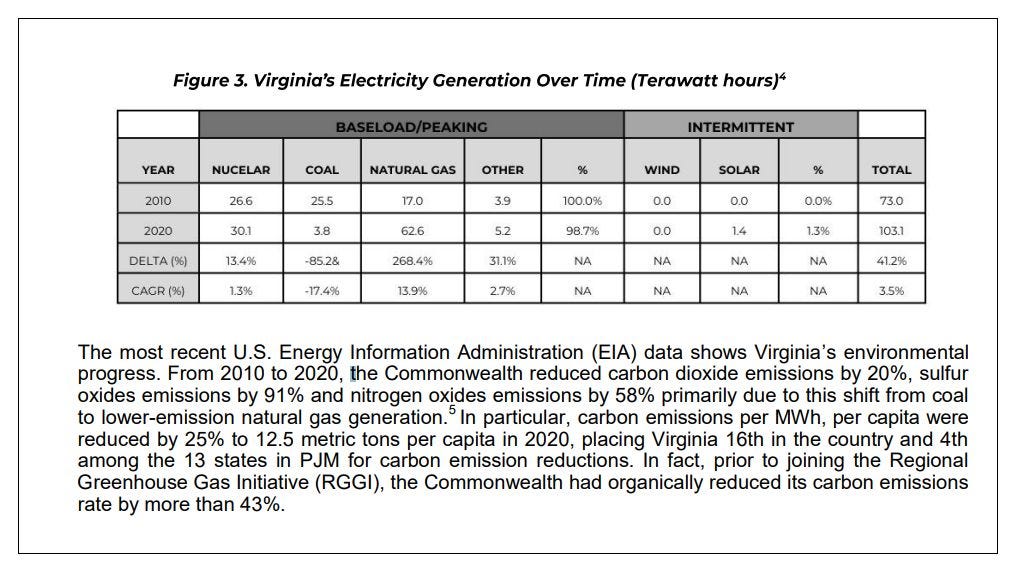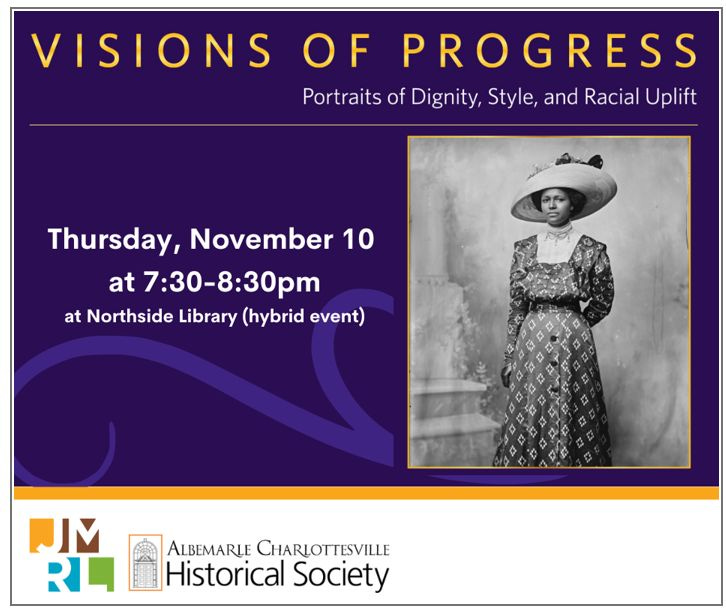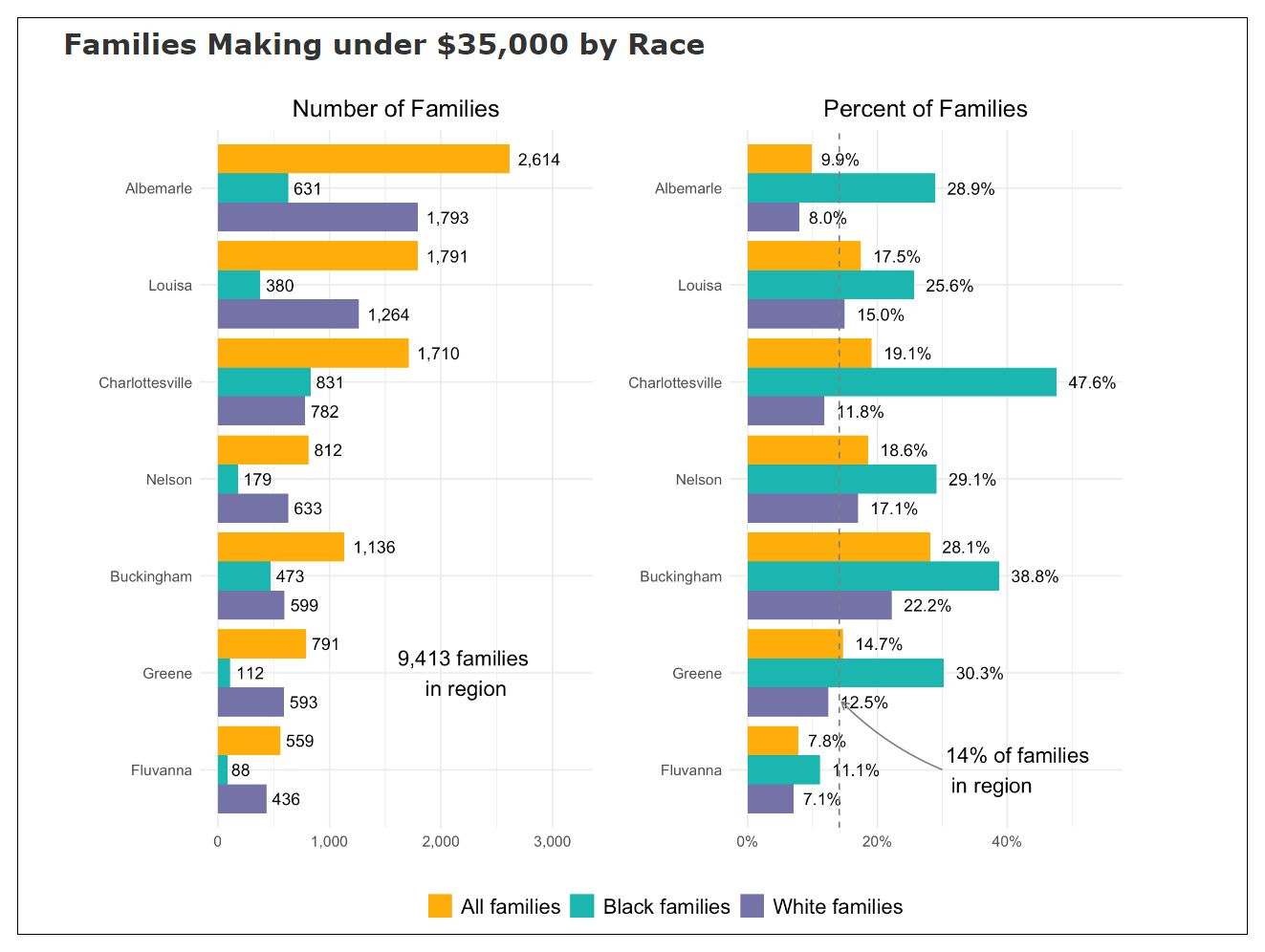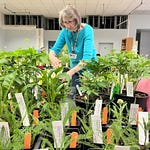October 28 is the day before the antepenultimate day before Halloween, a sentence that was as confusing to write as I’m sure it is to read. Sometimes words may seem unnecessary but there is often a case to be made for new entries to the English language. Some of them may appear from time to time in the paragraphs and soundbites of Charlottesville Community Engagement, a periodic publication preparing people on public policy. I’m Sean Tubbs, and I’m still figuring out what to call myself.
On today’s program:
The latest version of a report tracking the extent of poverty in the region has been released
The Virginia Supreme Court rules that Dominion Energy can add a surcharge to cover the cost of participating in a carbon cap and trade program
The state’s transportation body learns more about planning to extend the Roanoke train to the New River Valley
The Commonwealth Transportation Board also gets a status on Smart Scale three months before the latest scores are released
First shout-out: Visions of Progress with Dr. John Edwin Mason
In today’s first subscriber-supported shout-out, the Albemarle Charlottesville Historical Society continues its speaker series on November 10 by welcoming Dr. John Edwin Mason for a discussion of the "Visions of Progress" photography exhibition which is on display at UVA's Small Special Collections Library. Mason teaches African history and the history of photography at the University of Virginia.
The exhibition showcases portraits that African Americans in Central Virginia commissioned from Charlottesville's Holsinger Studio during the first decades of the twentieth century. This is a hybrid program, meaning that you can attend either in-person at Northside Library, or remotely via Facebook Live. Learn more at JMRL.
Latest report on family self-sufficiency is released
The number of families who don’t have enough income to cover the cost of living has decreased since 2011, according to the latest study from Network 2 Work at Piedmont Virginia Community College. The fifth version of the Orange Dot Report tracks households who make less than $35,000 in Charlottesville as well as Albemarle, Buckingham, Fluvanna, Greene, Louisa, and Nelson counties. (read the report)
“The comparable number of families struggling in the region in 2011 was 12,552, which was 21% of families,” reads a summary of the report. “The 2022 number–9,413 families–is a 25 percent reduction in the number of struggling families in the region.”
The report acknowledges that the cost of living has increased since that time, with $45,000 in income used as the figure for a single parent with a child in daycare.
“In this report, we continue to use the $35,000 income threshold as the break point for defining struggling families to remain consistent with the four prior reports,” the summary continues.

This is the first time Network2Work is partnering with the Equity Center at the University of Virginia. The report notes racial disparities such as 32 percent of Black families have incomes lower than $35,000 compared to 11 percent of white families. The main issue is that many professions are not valued.
“The undervaluing of Black labor has been reinforced through many policies from those we’ve collectively recognized as racially discriminatory—enslavement, Black codes, Jim Crow, Massive Resistance—to ongoing and often unacknowledged choices—a legacy of disinvestment in and displacement of Black communities, the blocking of wealth creation through red-lining and predatory lending, disproportionate contact with law enforcement and overincarceration, disenfranchisement and political demobilization, overt and subconscious negative stereotypes.”
The report also breaks down the situations in all of the localities. There’s a lot more information in the report and well worth your time.
Virginia Supreme Court rules in favor of utility charge for carbon reduction
The State Corporation Commission acted lawfully when it approved a request from the Virginia Electric and Power Company to add a surcharge to utility bills to cover the costs of purchasing carbon allowances in Regional Greenhouse Gas Initiative auctions. That’s according to an opinion yesterday by the Virginia Supreme Court.
“Though highly complex in its details, the [Carbon Dioxide] Budget Trading Program relies on a basic economic thesis: CO2 emissions can be reduced over time by making those responsible for them pay for the right to emit,” reads the opinion by Justice D. Arthur Kelsey.
The group Appalachian Voices had filed an appeal of the SCC decision and argued that the regulator did not follow the correct process. The Virginia Supreme Court disagreed.
Virginia Electric and Power Company is otherwise known as Dominion Energy. In November 2020, they filed a petition with the SCC stating they would need to purchase 29 million CO2 allowances at a cost of approximately $168 million to cover emissions. The SCC approved the “rate-adjustment clause” last November. Appalachian Voices challenged the approval and argued the RGGI rider was not shown to be “necessary.”
“The costs are recoverable, therefore, because they were necessary to comply with VEPCO’s statutory duty to purchase allowances for every short ton of CO2 emitted from its power plants,” reads page six of the opinion.
The ruling concludes that the appropriate venue for Appalachian Voices to argue for a least-cost program is when the SCC reviews plans for Dominion’s “renewable energy portfolio standard program.”

The nine-page ruling is a good place to start for anyone interested in learning more about how Virginia joined the Regional Greenhouse Gas Initiative through executive action in 2019 followed by adoption of the Clean Energy and Community Flood Preparedness Act in 2020 by the General Assembly.
Governor Glenn Youngkin, who has spent much of this year traveling to states and supporting Republican candidates, signed an executive order on his first day in office pledging to remove Virginia from RGGI. Legislation to dismantle the state’s participation in the cap-and-trade program failed in this year’s General Assembly, where each party has narrow control over one House.
In May, Dominion asked the SCC if it could suspend the charge due to Youngkin’s declaration, as reported in the Virginia Mercury.
In September, Youngkin’s acting Secretary of Natural Resources outlined a plan to leave RGGI administratively and called the surcharge a regressive tax. The energy plan released by the Youngkin administration earlier this month only mentions RGGI once in a passing comment that appears to state it is not needed to reduce greenhouse gas emissions.

Meanwhile, Virginia will participate in the 58th auction on December 7, 2022. The Commonwealth of Virginia has participated in seven auctions since it joined RGGI and has received $452,218,091.37.
Under law, 45 percent of the funding must go to the Virginia Community Flood Preparedness Fund.
Charlottesville has received three grants from the program with $153,000 to create a flood model for the Moores Creek watershed in round 1, $94,276 to create a Charlottesville Resilience Plan in round 2, and $275,000 to create a 2-dimensional stormwater management model for Meadow Creek and the Rivanna River in round 3.
“The primary function of the SWMM model is to analyze the watershed by using configurations to quantify flooding associated with both existing and future watershed conditions,” reads that grant application. Potential drainage improvement projects can be geospatially mapped in relation to predicted future flooding, so City staff can make assessments about the value of individual projects.”
In round 3, Albemarle County was successful in obtaining a $118,313 grant for a floodplain staff and resilience plan.
“While we typically have the funding and staffing necessary to implement and develop our major programs, this is not necessarily the case for emerging demands – such as flood resilience planning,” reads their application. “In addition to requiring more staff capacity to take on the development of a flood resilience plan, we also lack some of the internal technical expertise required for this type of endeavor.”
For a full list of awards, visit the Department of Conservation and Recreation’s website. To learn more about yesterday’s Virginia Supreme Court ruling, check out the Virginia Mercury’s Sarah Vogelsong.
RGGI tutorial
Second shout-out: JMRL to hold Food for Fines drive
In this second subscriber-supported shout-out: Be a hunger hero! Bring an item to the Front Desk of any JMRL location during business hours between November 7 and November 19 and receive $1 off overdue fines and late renewal fines for each donated item. Some of the most needed items are:
Canned soups, stews and chili - low sodium
Canned veggies - low sodium
Cereal - low sugar, whole grain
Peanut or almond butter - low sugar
Spaghetti sauce - low sugar
Donations from most branches will go to the Blue Ridge Food Bank, though those in Louisa County will go to the Louisa County Resource Council.
CTB briefed on second daily D.C. / Roanoke train
This past July, the Virginia Passenger Rail Authority began running a second Amtrak service between Roanoke and D.C.’s Union Station. This additional train had been planned for many years, but it took negotiations with Norfolk Southern to make it work.
“We negotiated a second train on that route because ridership in 2019 actually hit record highs on that route, one of the best routes in the county in terms of a cost benefit analysis so we added a second train starting July 11,” said Michael McLaughlin is the chief operating officer of the Virginia Passenger Rail Authority.
Some of the funding for the second train came from a larger initiative to address safety and congestion on the Interstate 81 corridor. This alternative to driving will extend to the New River Valley in a few years time.
“We have to do some infrastructure improvements though to get there, and we’re planning on getting there in 2026,” McLaughlin said.
The improvements include double-tracking seven miles of rail between Manassas and Culpeper, and improvements at the Roanoke rail yard to allow the passenger train to get through to Christiansburg.
“We’re also making improvements to something called the Virginia line,” McLaughlin said. “We purchased 28 miles of track from Salem to New River Valley on a secondary line Norfolk Southern owns.”
McLaughlin said the New River Valley station will be near the shopping mall in Christiansburg. A new route to the mall will need to be secured.
“So that will be an adventure to us to get the Virginia line down to the mall, but it’s the best place for the station to be,” McLaughlin said. “There’s currently transit at the mall and there’s the Huckleberry Trail which is a very popular trail, there’s always people on the trail that connects Blacksburg and Christiansburg.”
McLaughlin made his comments at this Tuesday’s meeting of the Commonwealth Transportation Board.
CTB briefed on Smart Scale funding as Round 5 scores
In three months, the Virginia Department of Transportation will release the results from the fifth round of Smart Scale, the major avenue through which projects related to roads and sidewalks are funded.
“We are in Smart Scale season,” said John Lawson, Virginia’s deputy transportation secretary. “Everybody will be wondering how much money will be available for this round and for many reasons it is to be determined.”
Lawson said there won’t be an estimate of revenues until Governor Glenn Youngkin releases his budget in December. He also said VDOT needs to know how much it needs to spend to cover the cost of inflation of existing projects.
But what is Smart Scale? Brooke Jackson of VDOT’s Office of Intermodal Planning and Investment said its the result of a 2014 law requiring the agency to rank projects on a series of metrics and make funding choices accordingly.
“In Smart Scale, we look at benefits relating to safety, congestion, accessibility, land use, environment, and economic development,” Jackson said.
There are 411 applications in the current cycle requesting $7.67 billion in funds with $18.6 million as the average request. There are several submissions from this area.
Virginia Transportation Secretary Shep Miller noted that 25 percent of the applications are to improve bike and pedestrian mobility. He said he wanted more scrutiny on those projects.
“If a bike-ped project brings congestion relief in transportation, then I think it sort of fits at the higher levels we’re trying to accomplish.” Miller said. “If it more about, particularly in the bike arena, if it’s more about sort of quality of life and the amount of people it serves is relatively small, I think we need to be thoughtful about how we spend our money.”
Miller said he wanted metrics on how much bike and pedestrian projects are actually used. As Secretary, he does not get a vote on the Commonwealth Transportation Board unless there is a tie.
“I’m a believe in bike/ped,” Miller said. “I’m just a believe in bike-ped when it’s utilized.”
CTB Member Mary Hynes said bike and pedestrian projects are often about safety.
“These are the vulnerable users that we’ve been talking about where we did need to focus and sometimes they are the folks with the least resources who are riding bikes and walking because they have no other choice,” Hynes said.
Three more months until Smart Scale Scores Day!
West Main Streetscape officially canceled
The Commonwealth Transportation Board takes action at the very end of their meeting and there were two items worth noting. The first was the renaming of a bridge in Nelson County as the Goffrey E. Miles Memorial Bridge.
“This is Route 6, Irish Road, over the Norfolk Southern railroad in Nelson County,” said Robbie Prezioso, a division administrator with VDOT. “In August of this past year, the county Board of Supervisors passed a resolution for this to honor Mr. Miles. He began working as a young man at the ripe old age of 13 at the local Lambert’s store in Faber. And he walked the railroad every day to go to work. That began a lifetime of tireless volunteering with the community, over 45 years with the Fire Department and over 30 years with the Rescue Squad.”
The resolution was adopted.
Next, there was action to cancel three Smart Scale projects administered by the City of Charlottesville. In addition to two phases of the West Main Streetscape, a project to reconfigure the intersection of Grady Avenue and Preston Avenue was canceled
There were also requests to increase funding for the Fontaine Avenue Streetscape and improvements at U.S. 29 and Hydraulic.
“Does anybody care if we take them as a block or does anyone want to do them individually?” Miller asked, with almost everyone saying block.
The item passed with no discussion.
So what’s next with West Main Street? The city of Charlottesville spent well over $2 million on a series of studies to design the West Main Streetscape, with absolutely nothing to show for it.
The main issue as identified by the current city leadership is a lack of project managers to handle all of the work the city said it could do. Will the situation improve as the current City Council considers policies to allow more homes to be built within city limits?
More on all of these issues in future editions of Charlottesville Community Engagement.
Other reading material:
Here’s what you need to know about the relocation of the owl, Amy Jablonkski, The Collegian, October 25, 2022
Good enough? A glimpse at Bob Good’s first term, Richard DiCicco, C-Ville Weekly, October 26 2022
Gone for Good? Josh Throneburg hopes to flip the 5th, Brielle Entzminger, C-Ville Weekly, October 26, 2022
Public defender tapped for defense in author's slaying, Hawes Spencer, Daily Progress, October 27, 2022
Opinion/Column: City's new policy wrongly muzzles employees, Will Creeley, Daily Progress
People’s Coalition accuses ACPD of racial profiling, ACPD responds, Dryden Quigley, NBC29, October 27, 2022
Albemarle-headquartered WillowTree sold for $1.225 billion, Bryan McKenzie, October 27, 2022
Ending comments for #451
Fun fact. I used to be in a punk rock back with the son of one of the people who is quoted in this newsletter. Listeners of the podcast can take a listen to one of the improvised songs from way back in 1999 at the end of today’s show.
This has been five straight days of production, and I’ve still not gotten to everything I wanted to get to, but there will time to get to them. My sole job is as the main producer of Town Crier Productions and there are hundreds of you who have stepped up to help cover the costs of doing the work.
The best way to do that is to sign up for a paid Substack subscription, which provides me a steady income so I can plan to keep doing this work well into the future when there’s next Orange Dot Report and when the Smart Scale numbers come in. People pay because they want to know, and I’ve trained for years to do this work.
If you do subscribe, Ting will match your first payment whether that be $5 a month, $50 a year, or $200 a year. If the latter, you also get shout-outs! Drop me a line and we can work something out.
And even if you opt not to pay for a subscription, Ting would still like your business for high-speed internet service and if you sign up through a link in the newsletter you will get free installation, a $75 gift card to the Downtown Mall, and a second month for free. Just enter the promo code COMMUNITY.
If you have any comments or questions about the program, I’m still looking for suggestions for the replacement for the phrase “School Board Member” please drop me a line.


















Share this post